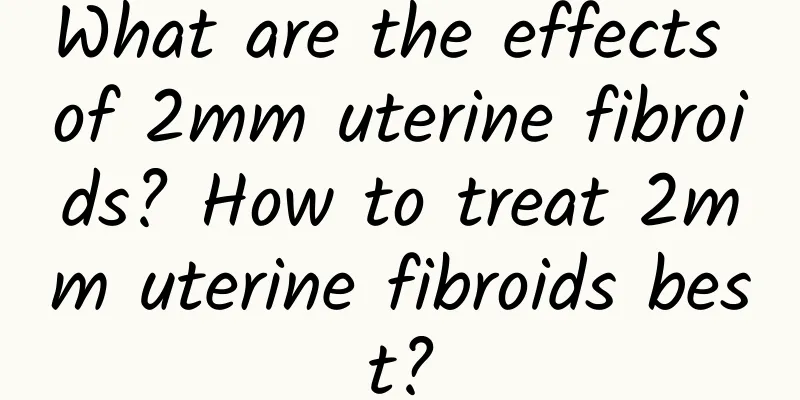What are the effects of 2mm uterine fibroids? How to treat 2mm uterine fibroids best?

|
What are the effects of 2 mm uterine fibroids: the first step to understanding the condition Uterine fibroids are a problem faced by many women. Among them, 2 mm uterine fibroids are relatively small fibroids, but they may still have some impact on the body. This article will explain the impact of 2 mm uterine fibroids and how to best treat this problem. Impact 1: Abnormal menstrual cycle Uterine fibroids as large as 2 mm may cause irregularities in the menstrual cycle. Some women may experience pain or discomfort at the beginning or end of their period. This is because fibroids increase pressure on the uterine muscles, which can cause pain and discomfort. Impact 2: Abnormal uterine bleeding Uterine fibroids as large as 2 mm may also cause abnormal uterine bleeding. Uterine fibroids can stimulate the growth of the uterine lining, which can lead to increased bleeding. This can cause noticeably heavier, longer, or irregular periods. If the bleeding is heavy, it can cause other health problems, such as anemia. Impact 3: Pregnancy problems 2mm uterine fibroids may cause some trouble during pregnancy. As the fibroids grow, they take up space in the uterus, which may not only increase the risk of miscarriage or premature birth, but may also interfere with the normal development of the embryo. Therefore, if you have uterine fibroids during pregnancy, you need to pay close attention. Treatment 1: Observation and monitoring For 2 mm uterine fibroids, observation and monitoring is a common treatment method. Because it is a smaller fibroid, some patients may not experience obvious symptoms. In this case, doctors usually recommend that patients have regular gynecological examinations to monitor the development of the fibroids. Treatment 2: Drug therapy Drug treatment is also a common method for 2 mm uterine fibroids. Some drugs can help shrink or control the growth of uterine fibroids. For example, oral contraceptives, progesterone drugs, and gonadotropin-releasing hormone drugs may be used to treat small uterine fibroids. Treatment three: surgical treatment In some cases, surgery may be the best option. For uterine fibroids that are 2 mm, surgical options include myomectomy and hysterectomy. Both of these surgeries can effectively remove the fibroids in the uterus and help restore normal uterine function. Although 2mm uterine fibroids are relatively small, they may still cause some effects on the body. Abnormal menstrual cycles, abnormal uterine bleeding, and pregnancy problems are common effects. In terms of treatment, observation and monitoring, drug therapy, and surgical treatment are common methods. Patients should choose appropriate treatment methods under the advice of their doctors and have regular gynecological examinations to monitor changes in their condition. Early detection and treatment of uterine fibroids can help protect women's health. |
>>: Why do uterine fibroids sometimes disappear suddenly?
Recommend
Why does vaginal candidal infection recur?
Why does candidal vaginitis recur? Candidal vagin...
How to face the premature ovarian failure caused by ovarian cysts
Premature ovarian failure is a common complicatio...
What are the types of painless abortion?
Painless abortion has been increasingly used in r...
Endometrial tuberculosis is not contagious
Is endometrial tuberculosis contagious? This is a...
Check for Clenbuterol! Hu Zhiqiang: We need to be more correct and transparent
On the 19th, the Taichung Municipal Government He...
What preparations should be done before abortion surgery
If a woman finds herself pregnant but does not wa...
Analysis of typical cases of acute pelvic inflammatory disease
The symptoms of acute pelvic inflammatory disease...
The specific causes of irregular menstruation are as follows
Irregular menstruation is a common gynecological ...
Why does vaginal discharge smell bad?
The odor of vaginal discharge is caused by vagina...
He Jiawen abused diet pills and gained 20 kg back
Artist He Jiawen recently revealed in an intervie...
What is cervical nabothian cyst?
Cervical nabothian cyst is a common gynecological...
Causes of pelvic inflammatory disease
Pelvic inflammatory disease refers to inflammatio...
Is it a disease if I don't have my period at the age of 20?
Is it a disease if I don’t have my period at the ...
Several major hazards of ovarian cysts to female patients
Among the many tumor diseases, ovarian cysts are ...
How to prevent recurrent miscarriage? Pay attention to these 4 points
The occurrence of recurrent miscarriage can indee...









